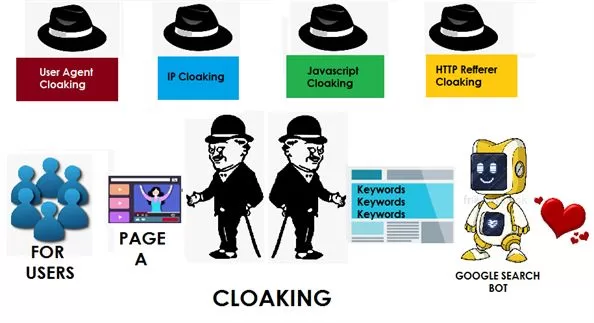What is Cloaking in SEO? How to Avoid It
What is Cloaking in SEO?
Cloaking in SEO is a black hat technique where a website presents a different URL or content to users and another one to search crawlers. This is an attempt to deceive search engines to rank the website higher in SERPs.
Cloaking is a direct violation of Webmaster Guidelines and leads to penalization in the form of a Google Penalty. A Google Penalty will result in a significant drop in rankings, which leads to less exposure, less engagement, and fewer conversions.

What are some Cloaking Practices?
There are a range of cloaking practices used to try and fool the bots. Some of them can be accidental though, so watch out.
1. Hidden Text
There are several techniques to create concealed text. Matching foreground colour and background color is a method used to hide text within a web page and is considered keyword stuffing.
Even though it might be an accident, Google nevertheless penalises it.
Websites can also hide text by using CSS or hiding text in JavaScript.
2. A Text to HTML Ratio That Is Inequitable
When a web page lacks content, webmasters frequently employ this strategy.
The text-to-HTML ratio of websites should be high; nevertheless, some websites increase the HTML ratio rather than enhancing and expanding on their content.
3. Displaying Flash to users but HTML to search engines
This type of “Agent Name Delivery” entails creating an HTML webpage.These pages appear content-rich to crawlers but present as Flash to users.
Does ‘White Hat Cloaking’ exist?
Matt Cutts has said:
“White hat cloaking is incompatible with Google’s philosophy. For “white hat” cloaking, we’ve never had to make an exception. That is risky if someone tells you that.
He added that Google views any code on a site that distinguishes the Googlebot based on the user agent or IP address as cloaking and may take action against the site.
This answers our query about whether “White Hat Cloaking” is allowed by Google’s webmaster rules. So, if someone suggests that you try white-hat cloaking, do not be duped.
What is Google’s penalty for cloaking?
Google takes a strong stance against and considers it a violation of their Webmaster Guidelines. If a website is found to be using to manipulate search engine rankings, it can face penalties including being removed from search engine results pages (SERPs) or even being banned from Google altogether. The penalties for cloaking can be severe, and it is important to avoid using in any form. Instead, concentrate on producing engaging content that is both optimised for consumers and search engines.
Should cloaking be done in SEO?
In the Search Engine Optimization (SEO) industry, cloaking is considered to be a black hat technique that violates Google’s Webmaster Guidelines.
If you ask us if you should use cloaking to deceive crawlers and achieve high rankings, we will say NO because search engines detest being duped. Plus, your website is crawled multiple times using different IP addresses and their complex and strict algorithm will detect cloaking on your website if you use it.
Make sure to keep in mind the methods we have mentioned in this post to know what is considered as by Google and what is not. Do let us know your thoughts by adding comments below.
How to Avoid Cloaking
Considering cloaking has such a negative impact on a website’s performance and authority, it’s best to keep an eye on it, and ensure you’re not breaking any rules.
- Review the elements of your website and ensure that all pages have a contrast of 4.5 to 1.
- Examine your site for text hidden in JavaScript. This must be done manually. Remove it and replace it with HTML if it is detected.
- Investigate if your site has text hidden by CSS. There are tools out there to help, like Screaming Frog.
What are Some Permitted Ways to Implement Cloaking in SEO?
While there has been some confusion over their status in the past, the following content delivery methods are permitted, and will not lead to a Google penalty.
1. Geo-location
Google uses geo-location to offer users with various web pages based on their location. A person in the US will see Google differently than a user in the UK, for instance.
2. URL Rewriting
This is the process of changing the appearance of a URL, to insert keywords and improve readability for SEO without altering the structure of a web page.
3. Flexible Sampling
This is where users clicking from Google to a listed page, are able to view the first page of content without subscribing to the host site. After the first page, there is barrier implemented.
Follow Us On LinkedIn
